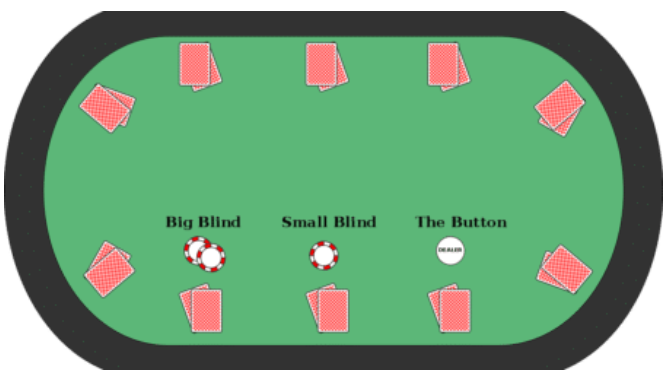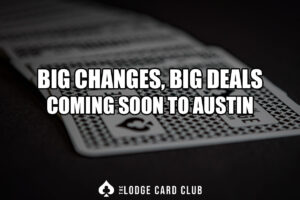If you play poker, or even just observe a hand, you’ll hear the terms small blind and big blind used quite often. These poker terms, known collectively as the blinds, are an essential part of Texas Hold’em, Omaha, and many other poker games.
The blinds are mandatory bets placed before the beginning of a poker hand. The small blind and big blind are posted from players in particular positions at the table, and those positions move one player to the left after each hand.
Here’s an expanded guide aimed at answering the question – what are poker blinds?
The Small Blind and The Big Blind
No-Limit Hold’em, Pot-Limit Omaha, and Big-O stand as the three most popular poker games played at the Lodge. Hold’em and Omaha (as well as several other poker games) use a betting structure that involves blinds and a button.
When you look at a NLH or PLO table, you’ll always see a disc labeled “BUTTON” or “DEALER” sitting in front of one player. The small blind position is on the direct left of the button, and the big blind position is to the direct left of the small blind.

When you look at the cash game list at the Lodge, you’ll see the listings include:
- $1/$2 NLH w/BP
- $1/$3 NLH w/BP
- $2/$5 NLH w/BP
- $1/$2/$5 PLO w/BP
The games listed here include No-Limit Hold’em (NLH) and Pot-Limit Omaha (PLO). The dollar amounts at the front of these listings represent the small blind and big blind amounts for that game.
The “BP” at the end of each listing stands for “bomb pot”, and you can read more about bomb pots here.
The blinds in a cash game essentially represent the stakes of a game. $1/$2 NLH is the lowest-stakes game you can play at the Lodge. The Lodge livestream, however, sometimes hosts games with blinds that go up to $200/$400!
At the Lodge (and at poker rooms in general), the max buy-in for a cash game goes up as the blinds go up. Consider the Lodge cash game listings with the allowed buy-in range added to the list:
- $1/$2 NLH w/BP ($100-$300 buy-in)
- $1/$3 NLH w/BP ($200-$1,000 buy-in)
- $2/$5 NLH w/BP ($200-$2,000 buy-in)
- $1/$2/$5 PLO w/BP ($200-$1,000 buy-in, match the stack)
As we can see here, the higher the blinds, the higher the max buy-in. There are games at the Lodge with even higher blinds, and with uncapped buy-ins (meaning you can put any amount of money on the table!)
Let’s sat you’re playing the $1/$2 NLH game at the Lodge. Every hand begins with the player in the small blind position putting $1 in the pot, and the player in the big blind putting $2 in the pot.
Once the cards are dealt, the preflop betting round begins. To stay in the hand, the first player to act must at least call the $2 big blind amount.
Straddles
In cash games, you’ll often see a player (or two or more players) put out a bet before the cards are dealt, for an amount bigger than the big blind. That move is called a “straddle” or “live straddle” and effectively increases the blind amount for the hand.
For example, you’ll quite often see the player in the under-the-gun position at a Lodge cash game table (the player to the immediate left of the big blind) put out a straddle. In a $1/$2 game, the straddle amount is often $5, but can be any size the player wants to make it.
The next-to-act player must at least call the $5 to continue in the hand. If nobody has raised when the action comes back around to the under-the-gun player, that player can either check their option, or raise.
For more on straddles, check out this guide from Upswing Poker.
How Do the Blinds Work in Poker Tournaments?
In a cash game, the blind amounts don’t change. If you sit in at a $1/$2 game at the Lodge, the small blind and big blind will always be $1 and $2.
The blinds work much differently when it comes to poker tournaments. In tournaments, the blinds increase in preset intervals known as “levels”. The amount of time in takes for a level to complete varies by tournament.
For instance, take a look at the structure for the Lodge’s weekly $15,000 Guaranteed Single Re-Entry Deep Stack tournament:
Sunday Single Re-Entry Deep Stack at the Lodge
- Buy-In: $250
- Starting Stack: 35,000 chips
- 30-minute levels (late entry allowed through Level 9)
- $15,000 guaranteed prize pool
- One re-entry allowed
In this popular weekly tournament, the levels are 30 minutes long, and the blinds start at 100/100. You get 35,000 chips to begin the tournament.
Every 30 minutes, the blinds increase. At Level 2, the blinds are 100/200. By the time Level 6 comes around, the blinds are 400/800.
Tournaments play out until only one player remains, and that player has won all of the chips in play. The escalating blinds in a tournament are necessary for the event to end in a reasonable amount of time.
If the blinds just stayed at 100/100 for the duration of a tournament where players had 35,000 starting chips, imagine how long it would take for one player to win all of the chips in play!
More Resources on How the Blinds Work in Poker:



